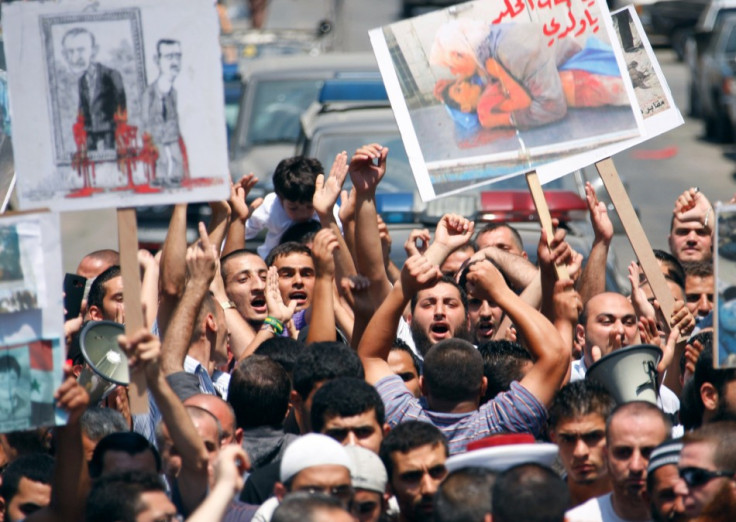Syria: Why Assad "Divide to Rule" Strategy Could Lead to His Demise

With popular uprising in Syria refusing to back down, cracks in the establishment are starting to show.
However unlike Tunisia or Egypt, it seems that despite months of popular protests the Assad family, in power in Syria for more than 40 years, is not yet ready to be ousted by the dissidents.
The conflict however impact on Syrian society every day a bit more, and political analysts are now convened that with a growing sectarianism further fracturing the civil society, a growing protest movement and a faltering economy, the country will instead be the first to pay the costs.
Bashar al-Assad, still backed by the Alawite minority, mainly centred in Damascus does not seem willing to back down of offer any real compromise despite calls from various countries for him to back down.
Just a few weeks ago, tensions between the Assad regime and the Obama administration surfaced after the U.S accused the government of helping prep anti-U.S. demonstrations.
Pro-Assad supporters were reportedly left angered after U.S. Ambassador Robert Ford and French Ambassador Eric Chevallier visited the city of Hama on July 7 to support anti-regime protesters.
"The situation has not reached a critical mass," said Patrick Seale, biographer of Bashar's father, Hafez al-Assad, to the Financial Time.
"Damascus hasn't risen, the security services haven't split yet, the economy hasn't collapsed. The regime looks weak and the opposition looks weaker, The Financial Times quoted him saying.
Syrian society is divided amongst several sectarian groups, including the Alawite, an off-shoot of Shi'ite Islam, a small number of Druze, Christian and non-Arab Kurds also make up the Syrian religious landscape while the majority are Sunni Muslim.
With so many strong sectarian groups all competing for more power and more political space- most group have for long criticised the repression led by the Assad forces, mainly made up of Alawite- observers are worried that a continuation of the standoff between demonstrators and the regime will only lead to a deeper societal fracture.
Many have said that the recent sectarian killings in the city of Homs this month may be assign that the conflict is turning very dangerous as more crimes directed targeting people with a different sectarian have been committed. Recently, four Alawite men were killed in Homs, with the reasons behind the killings still unexplained.
Others on the other end affirm that creating a sectarian divide was always part of the Assad plan, as he knows it will only make his enemies weaker.
While sources in Homs insist the killings were provoked by a ferocious security clampdown,after the regime security forces allegedly arrested and tortured , hundreds of men.
One thing that is for now sure however, is that Syria is becoming less and less secure, for pro-and anti-regime supporters and protesters alike.
Allegations of the authorities arming young men to help fight the insurgency are rife and accusation of torture by the regime forces so brutal it, in most cases leads to death, are a recurrent.
With the army desperately recruiting newcomers without necessary background checks, many predict the army could collapse or at least end up with people from different affronting factions armed. Assad is reportedly already suspicious of his own army and aware it could end up leading to his own downfall.
While many in Syria wish Assad would step down, an overtaking by the military, especially a divided one will not be good news for the Syrians, who have taken the streets asking for more rights and reforms for months.
The regime keeps on blaming Islamists for the unrest and while they certainly also push for the regime to fall, anti-Assad protesters are made up of a mix of different groups.
The protests were at first coming mainly from rural regions but have now spread though not on a huge scale, to Damascus.
As the protests have grown, so has repression, but Syrian residents insist they have now gone too far to backtrack and will continue demonstrating until the leader steps down.
Syria in the last few months has come a long way in expressing its anger at the government's corruption and brutal methods. While a year ago criticising Assad in public was a no go area, anti-Assad banners or graffiti can now be seen throughout Syria.
Meanwhile the future is looking even gloomier as the economy appears to have reached a standstill.
After growing at an average of 5 per cent over the last five years, it is now set to contract as much as 3 per cent this year as tourism, which accounts for 23 per cent of Syria's hard currency earnings, and foreign investment stall.
Assad's game of dividing to rule is a dangerous one and, should the conflict continue for another five or six months, many fear the Assad regime is not the only risking collapse.
© Copyright IBTimes 2025. All rights reserved.





















